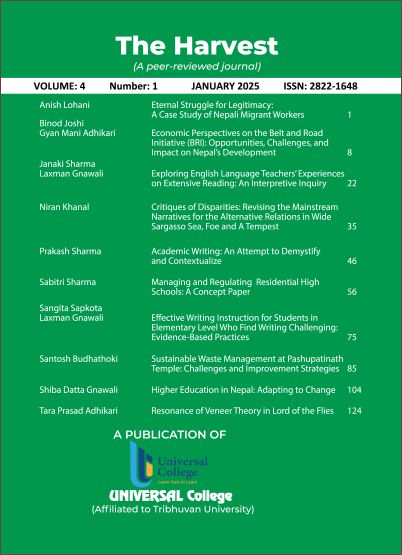Higher Education in Nepal: Adapting to Change
DOI:
https://doi.org/10.3126/harvest.v4i1.75358Keywords:
quality education, transformation, challenges, empower, knowledge, skills, tools, innovation, creativity, technology, motivation, pedagogy, curricula, collaboration, public-private-partnership, brain drain, better future, political interference, entrepreneurship, spirituality, unethical practicesAbstract
Higher education in Nepal has undergone significant transformations, evolving from a traditional system rooted in Gurukul learning to a more structured, modern university framework. The establishment of Tribhuvan University in 1959 marked the formal beginning of higher education in Nepal, followed by the expansion of public and private universities. Despite these developments, the education sector is struggling to struggle adapt to rapid social, economic, and technological changes.
This article explores the key challenges facing Nepalese higher education, including outdated curricula, inadequate infrastructure, limited research opportunities, and a lack of faculty development. The absence of a Federal Education Act has resulted in policy inconsistencies, further complicating governance. Additionally, excessive political interference has weakened institutional autonomy, affecting decision-making and quality enhancement. The exodus of students seeking better education abroad continues to drain financial and intellectual resources, exacerbating the issue of poor education quality characterized by rote learning and a weak research culture.
The article also examines the role of Public-Private Partnerships (PPP) and international collaboration in addressing these challenges. Strategic engagement with the private sector can enhance funding, infrastructure, and employability-focused programs, while global partnerships can improve faculty exchange, joint research, and academic standards.
Drawing from Nepal’s historical evolution of higher education and comparative insights from other developing nations, the discussion underscores the urgent need for policy stability, academia-industry linkages, institutional autonomy, and faculty training. Without decisive reforms, Nepal risks falling further behind in the global education landscape. The article concludes by emphasizing the importance of strategic partnerships and governance reforms in transforming Nepal’s higher education sector into a dynamic, inclusive, and competitive system.




